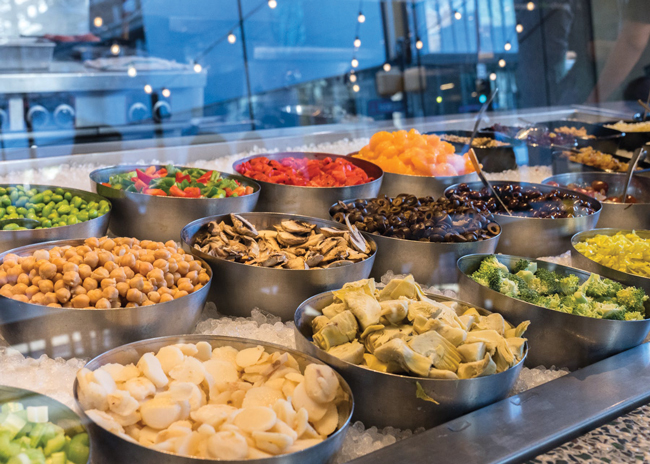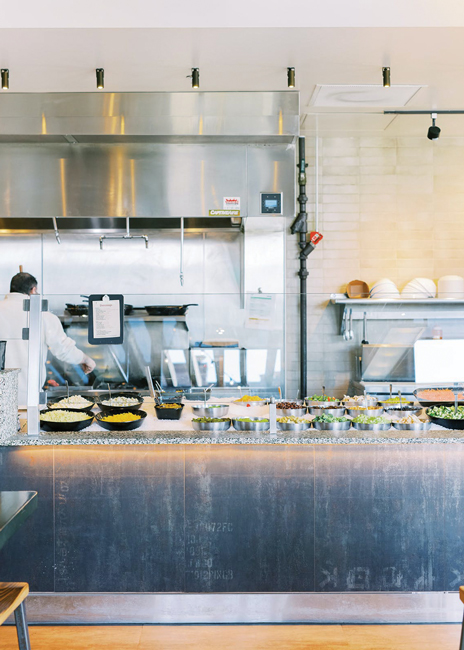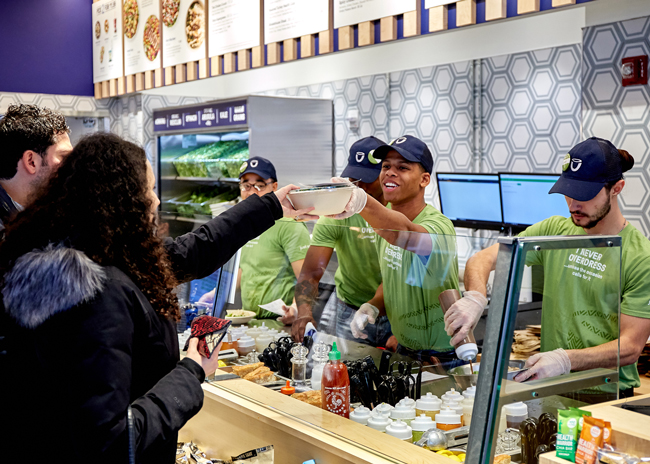The same thought went through the minds of many foodservice designers and operators when the coronavirus pandemic hit: There goes the salad bar.
Once a self-service value-add, in the wake of heightened safety and sanitation procedures, salad bars of the present and potentially the future will look a little different. Some self-service salad concepts, like Lettuce Souprise You, an all-you-can-eat salad concept in Atlanta, shut their doors for good; others, like Saladworks, approached closures as temporary and have reopened all but select stores, for example, a location in a mall. Nearly all made-to-order salad chains have had to make some adjustments in this new reality.
But the fact that there’s a pandemic does not mean consumers have lost their appetites for salads. In fact, 88% of consumers who were interested in simple ingredients before COVID-19 hit retain that interest, per a study from Chicago-based Datassential. In addition, 86% maintain a strong interest in plant-based foods.
In other words, salads remain as relevant a menu option as ever, forcing both self-serve and made-to-order concepts to update their go-to-market approaches to make guests feel safe. “Many of these concepts have had to rethink their entire business model,” says Brett Daniel, FCSI, project manager at Camacho, a Georgia-based foodservice consulting firm. “Salad stations and bars were all about designing for flexibility in the past, but that’s become even more important now and in the future.”
Joseph Schumaker, FCSI, president and CEO of FoodSpace, couldn’t agree more. “Everything we’re trying to do with salad bars and concepts is to create flexibility — this has been going on before COVID-19,” he says.
Schumaker is a fan of cold wells that can flip to become hot wells to hold warm protein toppers or perhaps warm grains for bowls. Additionally, Schumaker likes to make space for an undermount induction burner to add even more menu options for operators who want to do some minor cooking in front of guests, whether that’s warm proteins for salad and bowl toppings or even eggs in the morning. Plenty of undercounter refrigeration allows operators to hold a wider variety of ingredients at the makeline without the need to run to a back kitchen. This is especially important now, he adds, when social distancing is imperative.
Daniel adds, “No longer are operators using a single piece of equipment for one dedicated use; equipment needs to have dual or triple purpose these days.” When it comes to salad makelines, he says, adding multiuse high-speed ovens, for example, can bolster menu offerings without taking up too much additional space.
 Designing for flexibility to change between self-service and full-serve options is something consultants recommend for today's salad concepts. Image courtesy of Snappy Salads
Designing for flexibility to change between self-service and full-serve options is something consultants recommend for today's salad concepts. Image courtesy of Snappy Salads
Making the Switch
When it comes to self-service salad bars or concepts, Chris Wair, design principal at Indianapolis-based Reitano Design Group, doesn’t think they’re gone forever. However, certain changes are necessary in the wake of the global pandemic and heightened anxieties about safety and sanitation.
At the top of the list, Wair says, is to at least temporarily convert self-service salad stations to made-to-order ones. To do that, he closes off one side of the line to staff only, installing higher-than-average plexiglass to create a larger partition between the staff member and guests.
“We recommend using a convertible sneeze guard that can be used for both full-service and self-service depending on how you adjust the glass,” Wair says. “This piece has several adjustment levels that can lower all the way down or close all the way to the top. Convertible sneeze guards are more expensive up front, but in the long run, it will be easier for operators to react if we have another pandemic situation in the future.” At least one manufacturer currently offers an add-on plexiglass piece for existing sneeze guards to temporarily expand the barrier.
Schumaker, who also recommends blocking off one side of a self-service salad bar with plexiglass in this manner, notes the switch to full-service can introduce more labor costs. Another option, therefore, is to prepackage a variety of composed salads, bowls and other grab-and-go items, or even individually packaged ingredients like broccoli and dried fruit and nut toppings that can be made into a salad, and set them in the cold wells for easy pickup.
Another option that both Wair and Schumaker support is offering guests their own plastic tongs and a plate or bowl and allowing them to pick the items they want to prevent guests from having to touch the same tongs over and over. The only concern with this route, however, is to ensure that guests don’t cross-contaminate between raw ingredients and proteins/dairy for allergen and vegan/vegetarian customers. The proteins, therefore, might be set at the end of the line as the last item guests will pick up, if they want. Also, maybe the cheese toppings are packaged in individual containers.
Another way to handle a potential increase in labor when switching from a self-service to full-service salad line is to limit the number of ingredients available or push chef-created or composed salads that operators can customize on the back end if the customer doesn’t want a specific ingredient or wishes to add a topping to their order. “This way, you’re not making anything fully from scratch,” says Wair.
Even made-to-order salad concepts, Wair adds, would fare better by limiting the menu in this way, especially during a pandemic when operators don’t want crowds forming. Doing so also enhances efficiencies and throughput, and cuts down on food costs.
 Image courtesy of Snappy SaladPackaging Conundrum
Image courtesy of Snappy SaladPackaging Conundrum
On the one hand, many salad concepts were already on their way toward going 100% compostable when it comes to packaging. During the pandemic this trend seemingly has accelerated. That said, operators
should think about where those compostable bowls, covers, forks, knives and spoons will reside on the line, Wair says. He recommends that operators store them on shelves over the counter rather than below because employees can tire quickly if they have to bend down to reach for a new bowl every time a customer comes down the line.
Schumaker notes that while many people perceive using 100% disposables in a foodservice operation to be the cleaner option right now, that’s not necessarily the case. “You still have the same amount of touch points on disposables that you do on permanent ware,” he says. “A dish machine-sanitized plate is not more or less risky than a compostable box, and if we simply introduce more compostable items, we might solve one problem but add to the older problem of excess waste that we were trying to fix.”
Display, Display, Display
Pandemic or not, display is key when it comes to salad concepts and bars. “Whether it’s a self- or full-service salad line, you always want to put ample amounts of product for display in the wells,” says Daniel, who also recommends see-through glass lids for items in a refrigerated prep table. “You don’t want to hide any of that; that doesn’t change,” he says.
Daniel has also designed makelines where the proteins sit in the middle, with mirrored ingredients on either end so staff can make salads on one side and bowls or sandwiches on the other.
Schumaker points out that some salad concepts have pivoted to selling whole produce, so there might be more demand for fresh vegetable and fruit displays in the future. “You want the space to look full, just like a grocery store,” he says.
Contactless, Touchless Spaces
Ordering apps and technology will continue to grow in popularity among salad concepts, especially in a pandemic, Wair says. “There will be different methods of getting food from the kitchen to the customer.” That includes more shelving or warm/cold cubbies that customers can unlock with their phones to retrieve preordered food.
To further reduce touch points at the front of the house, many restaurants have done away with condiment stations and self-service beverage stations. Instead, the trend is to offer individual condiment packages or pre-prepped ramekins full of ketchup, mustard, and the like.
“We also won’t see guests grabbing forks out of a bin anymore,” says Schumaker. “We might see more dining room attendants placing silverware settings on tables and sanitizing chairs.” And no more bottles of salad dressings — maybe it’s all on the side going forward.
When it comes to salad concept design in general, says Schumaker, “at the end of day, I think it’s up to each operator and each facility to think about their guests and what’s going on in local areas regarding the pandemic and creating strategies that can still allow for some customization.” He adds, “Everyone wants to find the magic answer, but there really is no cookie-cutter approach. Operators will have to figure out what fits for their region and client base, but the good news is there is a litany of ideas out there.”
A Look at Salad Collective
Golden, Colo.-based Salad Collective launched last year after a merger between Mad Greens and Snappy Salads. Each brand continues to operate under its respective names as made-to-order, build-your-own salad and grain bowl concepts. Founded in 2004, Mad Greens has 33 locations across Colorado, Arizona, and Texas, while Snappy Salads has 14 locations in Texas throughout the Dallas-Fort Worth area.
Starting at 6 a.m. daily, staff at both concepts begin to prep proteins, fruits, vegetables and 20 salad dressings, storing overflow in undercounter refrigeration along the main salad makeline, says Peggy Littleton, director of marketing for Salad Collective. On the makeline at Snappy Salads, metal containers of prepped salad ingredients sit on top of ice. That might change in the future, though, to mirror Mad Greens’ refrigerated prep line.
Another main difference between the two concepts: Mad Greens puts out cooked and chilled proteins next to the greens on the refrigerated line, while staff at Snappy Salads cook proteins to order behind the line and bring the ingredients out on a small tray that staff set at the end of the line. at the end of the line. Both concepts feature a robust back-of-the-house kitchen which, depending on the location, is fully or partially visible to guests. This space includes two ovens, a large flattop grill and a fryer for cooking proteins, as well as a walk-in cooler and extra prep space.
At both Mad Greens and Snappy Salads, guests start down the line moving left to right, choosing their greens first. Staff add the greens to large metal mixing bowls using tongs that rest on a rack next to the line. Next, customers choose their proteins and then fresh veggies and fruits before selecting crunchy toppings like nuts, seeds and wonton strips. The bowl then travels to the dressing station, which is a custom-fabricated, refrigerated well with circular cutouts holding squeeze bottles with larger openings for creamy dressings and tighter ones for thinner vinaigrettes. Bottles of olive oil and vinegar sit next to the dressings. Customers can choose to have their salads tossed with a dressing or have their dressing on the side. Staff use a custom, recyclable clamshell container for salads that include dressing on the side; a proportioned container of dressing sits on top of the to-go container. The location of the dressing on the top helps remind staff not to forget the container, Littleton says.
“The mixing bowls and tongs are then placed into a bus bin that sits under the register or behind it to get washed and returned to the line,” Littleton says. There’s a place for packaging to sit on the line just before customers reach the register.
In the early days of the coronavirus pandemic in mid-March, both Mad Greens and Snappy Salads restaurants shut down completely for five weeks to protect the safety of staff and consider what changes would be necessary upon reopening. Neither concept has yet to resume dine-in service, though they have ramped up delivery through third-party vendors as well as company-owned vehicles.
“There are hand sanitizers everywhere now, and we took out all of the self-serve condiments and lemons and instead installed signs to showcase those offerings that guests can ask for when they check out,” Littleton says. The chain already had plexiglass along the salad makeline and a natural distance of 6 feet between the staff members and customers, so that didn’t have to change. All permanent ware has been replaced by to-go packaging. Of course, all employees are required to wear masks and gloves. While the company has incurred some losses when it comes to the business-lunch crowd, delivery sales have filled that gap. “People still want their salads,” Littleton says.
 Image Courtesy of Just Salad
Image Courtesy of Just Salad
Watch-Worthy Made-to-Order Salad Chains
Based in New York, this made-to-order salad concept pivoted during COVID-19-related closures to launch Just Grocery, an on-demand delivery service offering fruit and vegetables and additional household staples. This service also offers pantry items like granola bars and chips, and meal kits for two that include Just Salad’s signature salads. Just Salad delivers orders in 90 minutes or less to residents in Manhattan. The chain has nearly 50 locations in New York, New Jersey, Florida, Illinois and Pennsylvania.
This California-based, made-to-order salad concept with locations predominantly in areas with many office buildings had to make significant changes to maintain its busy lunch crowd during closures due to the coronavirus. The company leveraged its delivery service and app-based ordering technology to boost its off-premises business, and it also opened up more Outposts, a hybrid delivery-catering model which serve as pickup locations at office buildings. The chain also now offers bulk family meals for delivery and takeout. As restaurants began to reopen, Sweetgreen reiterated its dedication to safety and sanitation, assigning staff to serve as concierges to assist with safe order pickup and enhanced cleaning. The chain also installed hand-sanitizing stations in all restaurant locations and at Outposts and is encouraging contact-free, cashless payment through its app. For those who choose to pay in-store, Sweetgreen installed cashier shields and is managing crowds at pickup shelves.
This New York-based, family-owned business founded in 2010 sources fresh produce from the fresh&co farm in Long Island. Its menu offers salads, grain bowls and sandwiches in chef-created or build-your-own formats. The chain also uses an app for online ordering, delivery and contactless payment. In July, fresh&co announced it would bolster its franchise program, which began in 2018, as part of its goal to expand throughout the Northeast. The chain currently operates 17 corporate-owned restaurants throughout Manhattan and one in Brooklyn, but through the franchise program, co-founder and CEO George Tenedios said in a statement that he plans to expand to underserved neighborhoods in the boroughs as well as on Long Island and in New Jersey, while also opening three to five new corporate stores each year. A franchise agreement has been signed for three restaurants in Westchester, N.Y.



